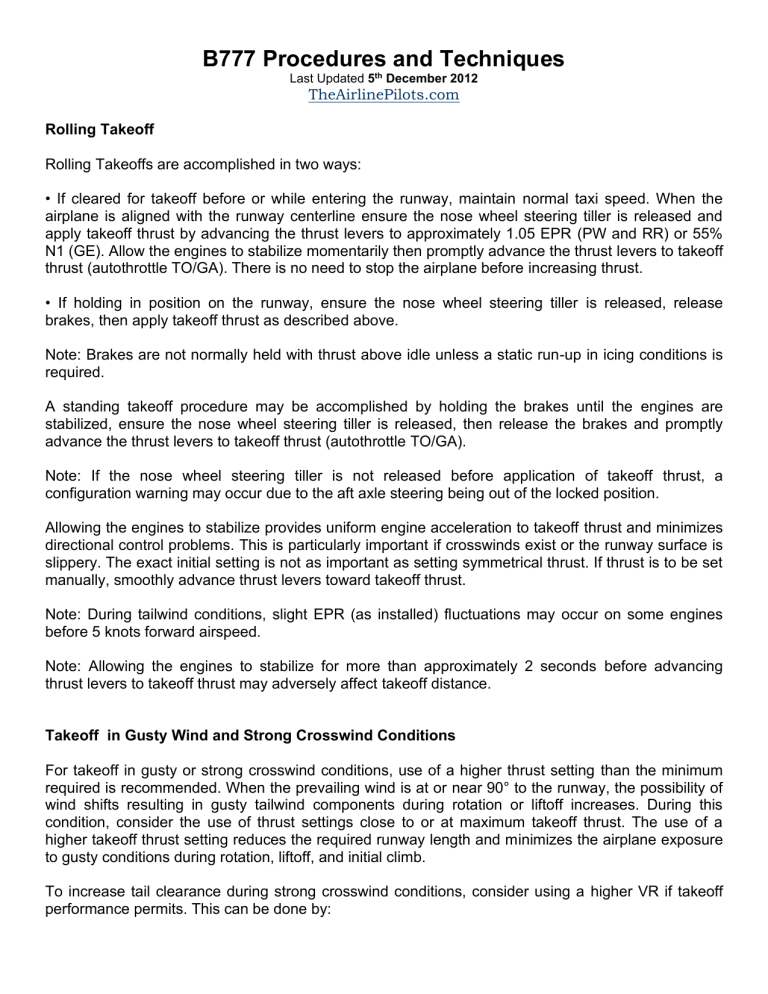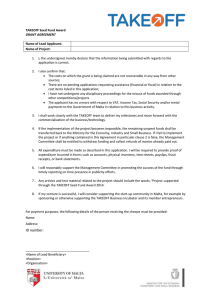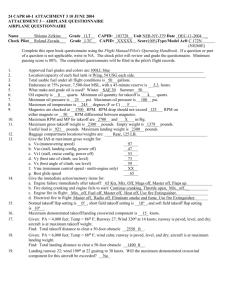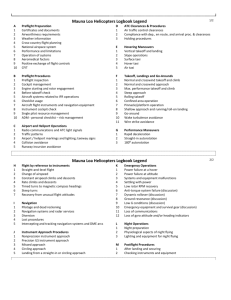
B777 Procedures and Techniques Last Updated 5th December 2012 TheAirlinePilots.com Rolling Takeoff Rolling Takeoffs are accomplished in two ways: • If cleared for takeoff before or while entering the runway, maintain normal taxi speed. When the airplane is aligned with the runway centerline ensure the nose wheel steering tiller is released and apply takeoff thrust by advancing the thrust levers to approximately 1.05 EPR (PW and RR) or 55% N1 (GE). Allow the engines to stabilize momentarily then promptly advance the thrust levers to takeoff thrust (autothrottle TO/GA). There is no need to stop the airplane before increasing thrust. • If holding in position on the runway, ensure the nose wheel steering tiller is released, release brakes, then apply takeoff thrust as described above. Note: Brakes are not normally held with thrust above idle unless a static run-up in icing conditions is required. A standing takeoff procedure may be accomplished by holding the brakes until the engines are stabilized, ensure the nose wheel steering tiller is released, then release the brakes and promptly advance the thrust levers to takeoff thrust (autothrottle TO/GA). Note: If the nose wheel steering tiller is not released before application of takeoff thrust, a configuration warning may occur due to the aft axle steering being out of the locked position. Allowing the engines to stabilize provides uniform engine acceleration to takeoff thrust and minimizes directional control problems. This is particularly important if crosswinds exist or the runway surface is slippery. The exact initial setting is not as important as setting symmetrical thrust. If thrust is to be set manually, smoothly advance thrust levers toward takeoff thrust. Note: During tailwind conditions, slight EPR (as installed) fluctuations may occur on some engines before 5 knots forward airspeed. Note: Allowing the engines to stabilize for more than approximately 2 seconds before advancing thrust levers to takeoff thrust may adversely affect takeoff distance. Takeoff in Gusty Wind and Strong Crosswind Conditions For takeoff in gusty or strong crosswind conditions, use of a higher thrust setting than the minimum required is recommended. When the prevailing wind is at or near 90° to the runway, the possibility of wind shifts resulting in gusty tailwind components during rotation or liftoff increases. During this condition, consider the use of thrust settings close to or at maximum takeoff thrust. The use of a higher takeoff thrust setting reduces the required runway length and minimizes the airplane exposure to gusty conditions during rotation, liftoff, and initial climb. To increase tail clearance during strong crosswind conditions, consider using a higher VR if takeoff performance permits. This can be done by: • Using improved climb takeoff performance • Increasing VR speed to the performance limited gross weight rotation speed, not to exceed actual gross weight VR + 20 knots. Set V speeds for the actual gross weight. Rotate at the adjusted (higher) rotation speed. This increased rotation speed results in an increased stall margin, and meets takeoff performance requirements. Avoid rotation during a gust. If a gust is experienced near VR, as indicated by stagnant airspeed or rapid airspeed acceleration, momentarily delay rotation. This slight delay allows the airplane additional time to accelerate through the gust and the resulting additional airspeed improves the tail clearance margin. Do not rotate early or use a higher than normal rotation rate in an attempt to clear the ground and reduce the gust effect because this reduces tail clearance margins. Limit control wheel input to that required to keep the wings level. Use of excessive control wheel increases spoiler deployment which has the effect of reducing tail clearance. All of these factors provide maximum energy to accelerate through gusts while maintaining tail clearance margins at liftoff. The airplane is in a sideslip with crossed controls at this point. A slow, smooth recovery from this sideslip is accomplished after liftoff by slowly neutralizing the control wheel and rudder pedals No V Speeds during takeoff There have been incidents where pilots have missed FMC alerting messages informing them that the takeoff speeds have been deleted or they have forgotten to set the airspeed bugs. If, during a takeoff, the crew discovers that the V speeds are not displayed and there are no other fault indications, the takeoff may be continued. The lack of displayed V speeds with no other fault indications does not fit any of the published criteria for rejecting a takeoff (refer to the Rejected Takeoff NNM in the QRH). In the absence of displayed V speeds, the PM should announce V1 and VR speeds to the PF at the appropriate times during the takeoff roll. The V2 speed should be displayed on the MCP and primary airspeed indicators. If neither pilot recalls the correct rotation speed, rotate the airplane 5 to 10 knots before the displayed V2 speed. Combination ATM and Fixed Derate Takeoff - Combination ATM and Fixed Derate Note: All limitations and restrictions for reduced takeoff thrust (ATM) and derated takeoff thrust (fixed derate) must be observed. Reduced takeoff thrust (ATM) and derated takeoff thrust (fixed derate) may be combined by first selecting a fixed derate and then an assumed temperature higher than the actual ambient temperature. Although the takeoff thrust setting is not considered a takeoff operating limit for the ATM thrust reduction, the selected fixed derate is still considered a takeoff operating limit since takeoff speeds consider VMCG and VMCA only at the fixed derate level of thrust. Since the crew has no indication of the fixed derate limit, thrust levers should not be advanced unless conditions are encountered during the takeoff where additional thrust is needed on both engines, such as a windshear condition. If an engine failure occurs during takeoff, any thrust increase beyond the fixed derate limit could result in loss of directional control. High Takeoff Thrust - Low Gross Weight When accomplishing a low altitude level off following a takeoff using high takeoff thrust and at a low gross weight, the crew should consider the following factors: • Altitude capture can occur just after liftoff due to the proximity of the level off altitude and the high climb rate of the airplane • The AFDS control laws limit F/D and autopilot pitch commands for passenger comfort • There may not be enough altitude below the intended level off altitude to complete the normal capture profile and an overshoot may occur unless crew action is taken. To prevent an altitude and/or airspeed overshoot, the crew should consider doing one or more of the following: • Use reduced thrust for takeoff at low weights whenever possible • Reduce from takeoff to climb thrust earlier than normal disengage the AFDS and complete the level off manually if there is a possibility of an overshoot • Use manual thrust control as needed to manage speed and prevent flap overspeeds. Bank Angle Limit For LNAV operation, the FMC provides a real-time bank angle limiting function. This function protects the commanded bank angle from exceeding the current available thrust limit. This bank angle limiting protection is only available when in LNAV. For operations other than LNAV, when operating at or near maximum altitude fly at least 10 knots above the lower amber band and use bank angles of 10° or less. If speed drops below the lower amber band, immediately increase speed by doing one or more of the following: • Reduce angle of bank • Increase thrust up to maximum continuous • Descend. Fuel Burn The planned fuel burn can increase due to: • Temperature above planned • A lower cruise altitude than planned • Cruise altitude more than 2,000 feet above optimum altitude • Speed faster than planned or appreciably slower than long range cruise speed when long range cruise was planned • Stronger headwind component • Fuel imbalance • Improperly trimmed airplane • Excessive thrust lever adjustments. Cruise fuel penalties can be approximated using the following guidance. For flight planning purposes, reference the appropriate airplane Flight Planning and Performance Manuals: • ISA + 10° C: 1% increase in trip fuel • 2,000 feet above optimum altitude: 1% to 2% increase in trip fuel • 4,000 feet below optimum altitude: 4% to 5% increase in trip fuel • 8,000 feet below optimum altitude: 12% to 14% increase in trip fuel • Cruise speed 0.01M above scheduled: 1% to 2% increase in trip fuel. For cruise within 2,000 feet of optimum, long range cruise speed can be approximated by using 0.84M. Long range cruise also provides the best buffet margin at all cruise altitudes. Flight Control Sensitivity at High Speed and High Altitude Pilots should understand that, in general, the airplane is significantly more sensitive in pitch response (load factor) to column movement at cruise than it is at lower speeds associated with takeoff and landing. Similarly, for a given attitude change, the change in rate of climb is proportional to the true airspeed. For example, an attitude change at 290 knots KIAS at sea level that results in a 500 fpm rate of climb would result in approximately a 900 fpm rate if done at 290 knots KIAS at 35,000 feet. This is because 290 KIAS is equivalent to a TAS of approximately 290 knots at sea level and 490 knots at 35,000 feet. This characteristic is essentially true for small attitude changes, such as the kind used to hold altitude. PROC HOLD When a procedure holding pattern is selected from the navigation database and the FMC shows PROC HOLD on the legs page, the following is true when the PROC HOLD is the active leg: • Exiting the holding pattern is automatic; there is no need to select EXIT HOLD • If the crew desires to remain in holding a new holding pattern must be entered. Holding Airspeeds Not Available from the FMC If holding speed is not available from the FMC, refer to the PI chapter in Volume 1 of the FCOM. If time does not permit immediate reference to the FCOM, the following speed schedule may be used temporarily. This simplified holding speed schedule may not match the FMC or QRH holding speeds because the FMC and QRH holding speeds are based on many conditions that cannot be generalized into a simple schedule. However, this schedule provides a reasonable approximation of minimum fuel burn speed with appropriate margins to initial buffet. Recommended holding speeds can be approximated by using the following guidance until more accurate speeds are obtained from the QRH: • Flaps up maneuver speed approximates minimum fuel burn speed and may be used at low altitudes • 777-200, 777-300: Above FL250, use VREF 30 + 100 knots to provide at least a 0.3 g margin to initial buffet (full maneuver capability) • 777-200LR, 777-300ER: Above 10,000 feet, use VREF 30 + 120 knots to provide at least a 0.3 g margin to initial buffet (full maneuver capability). Command Speed for Landing - Normal When using the autothrottle, position command speed to VREF + 5 knots. If a manual landing is planned with the autothrottle connected in gusty or high wind conditions, consider positioning the command speed to VREF + 10 knots. If the autothrottle is disconnected, or is planned to be disconnected prior to landing, the recommended method for approach speed correction is to add one half of the reported steady headwind component plus the full gust increment above the steady wind to the reference speed. When making adjustments for winds, the maximum approach speed should not exceed VREF + 20 knots. Do not apply wind additives for tailwinds. Set command speed at VREF + 5 knots (autothrottle engaged or disconnected). Factors Affecting Landing Distance Height of the airplane over the runway threshold also has a significant effect on total landing distance. For example, on a 3° glide path, passing over the runway threshold at 100 feet altitude rather than 50 feet could increase the total landing distance by approximately 950 feet. This is due to the length of runway used up before the airplane actually touches down. Glide path angle also affects total landing distance. As the approach path becomes flatter, even while maintaining proper height over the end of the runway, total landing distance is increased. Fail Operational Fail operational refers to an AFDS capable of completing an ILS approach, autoland, and rollout following the failure of any single system component after passing alert height. Category III operations using fail operational autoland systems normally do not require specific visual references below AH. Fail Passive Fail passive refers to an AFDS which in the event of a failure, causes no significant deviation of airplane flight path or attitude. A DA(H) is used as approach minimums. Category III operations using fail passive autoland systems typically apply a DH of 50 ft. when approaching the threshold. In this instance, criteria requires that the runway environment be clearly visible. If not, execute an immediate missed approach. Crosswind Landing Techniques 1. De-Crab During Flare The objective of this technique is to maintain wings level throughout the approach, flare, and touchdown. On final approach, a crab angle is established with wings level to maintain the desired track. Just prior to touchdown while flaring the airplane, downwind rudder is applied to eliminate the crab and align the airplane with the runway centerline. As rudder is applied, the upwind wing sweeps forward, developing roll. Hold wings level with simultaneous application of aileron control into the wind. 2. Touchdown in Crab The airplane can land using crab only (zero sideslip) up to the landing crosswind guideline speeds. Touchdown in a crab only condition is not recommended when landing on a dry runway in strong crosswinds. On very slippery runways, landing the airplane using crab only reduces drift toward the downwind side at touchdown, permits rapid operation of spoilers and autobrakes because all main gears touchdown simultaneously, and may reduce pilot workload since the airplane does not have to be decrabbed before touchdown. 3. Sideslip (Wing Low) The sideslip crosswind technique aligns the airplane with the extended runway centerline so that main gear touchdown occurs on the runway centerline. The initial phase of the approach to landing is flown using the crab method to correct for drift. Prior to the flare the airplane centerline is aligned on or parallel to the runway centerline. Downwind rudder is used to align the longitudinal axis to the desired track as aileron is used to lower the wing into the wind to prevent drift. A steady sideslip is established with opposite rudder and low wing into the wind to hold the desired course. Overweight Landing If the landing weight is less than the landing climb limited weight but above the maximum landing weight and both engines are operative, an additional landing approach speed check must be made. This landing approach speed check is required to ensure that there is at least a 10 knot margin between the flaps 30 landing approach speed (VREF 30 plus additives for wind and gusts) and the flaps 30 placard speed. If a 10 knot margin exists, then flaps 30 is the recommended landing flap. However, if a 10 knot margin does not exist, then flaps 25 is the recommended landing flap and VREF 25 plus additives for wind and gusts is the recommended landing approach speed. Observe flap placard speeds during flap extension and on final approach. In the holding and approach patterns, maneuvers should be flown at the normal maneuver speeds. During flap extension, airspeed can be reduced by as much as 20 knots below normal maneuver speeds before extending to the next flap position. These lower speeds result in larger margins to the flap placards, while still providing normal bank angle maneuver capability, but do not allow for a 15° overshoot margin in all cases. Overweight Autolands Overweight autolands are not recommended. Autopilots on Boeing airplanes are not certified for automatic landings above maximum landing weight. In an emergency, should the pilot determine that an overweight autoland is the safest course of action, the approach and landing should be closely monitored by the pilot and the following factors considered: • Touchdown may be beyond the normal touchdown zone; allow for additional landing distance • Touchdown at higher than normal sink rates may result in exceeding structural limits • Plan for a go-around or manual landing if autoland performance is unsatisfactory AFDS ROLLOUT Mode AFDS ROLLOUT mode performance cannot be assured when used on contaminated runways. The ROLLOUT mode relies on a combination of aerodynamic rudder control, nose wheel steering and main gear tracking to maintain the runway centerline using localizer signals for guidance. On a contaminated runway, nose wheel steering and main gear tracking effectiveness, and therefore airplane directional control capability, is reduced. If an autoland is accomplished on a contaminated runway, the pilot must be prepared to disengage the autopilot and take over manually should ROLLOUT directional control become inadequate. Carbon Brake Life Brake wear is primarily dependent upon the number of brake applications. For example, one firm brake application causes less wear than several light applications. Continuous light applications of the brakes to keep the airplane from accelerating over a long period of time (riding the brakes) to maintain a constant taxi speed produces more wear than proper brake application. During taxi, proper braking should involve applying brakes to decelerate the airplane, releasing the brakes when the lower speed is attained and allowing the airplane to accelerate, then repeating. During landing, one hard, high energy, long-duration brake application produces the same amount of wear as a light, low-energy, short application. This is different from steel brakes that wear as a function of the energy input during the stop. For normal landing conditions, autobrakes 2 or 3 optimizes brake wear, passenger comfort, and stopping performance. Since autobrake settings apply the brakes dependant upon the deceleration rate, an autobrake setting of 1 results in a higher probability that the autobrakes will modulate, especially when the reversers are used. Autobrakes 2 or 3 results in a continuous brake application, which can increase carbon brake life. Was this document helpful? Click here to Answer! Disclaimer: "B777 Procedures and Techniques" are personal notes of the undersigned. These notes do not sanction any pilot to violate his/her Company's Standard Operating Procedures, Aircraft Manuals or Manufacturer's Recommendations.





